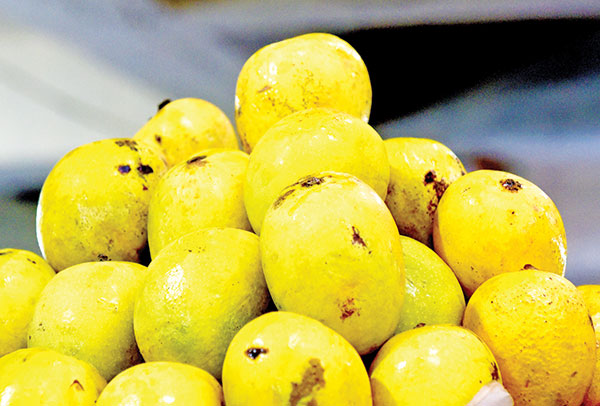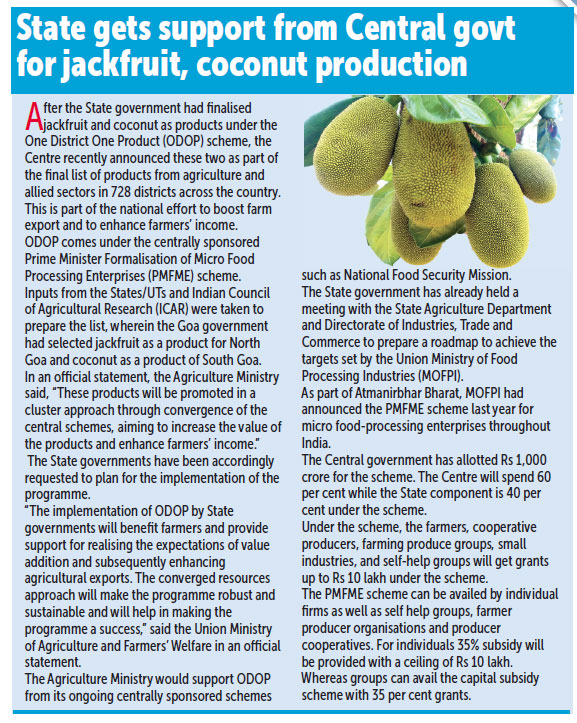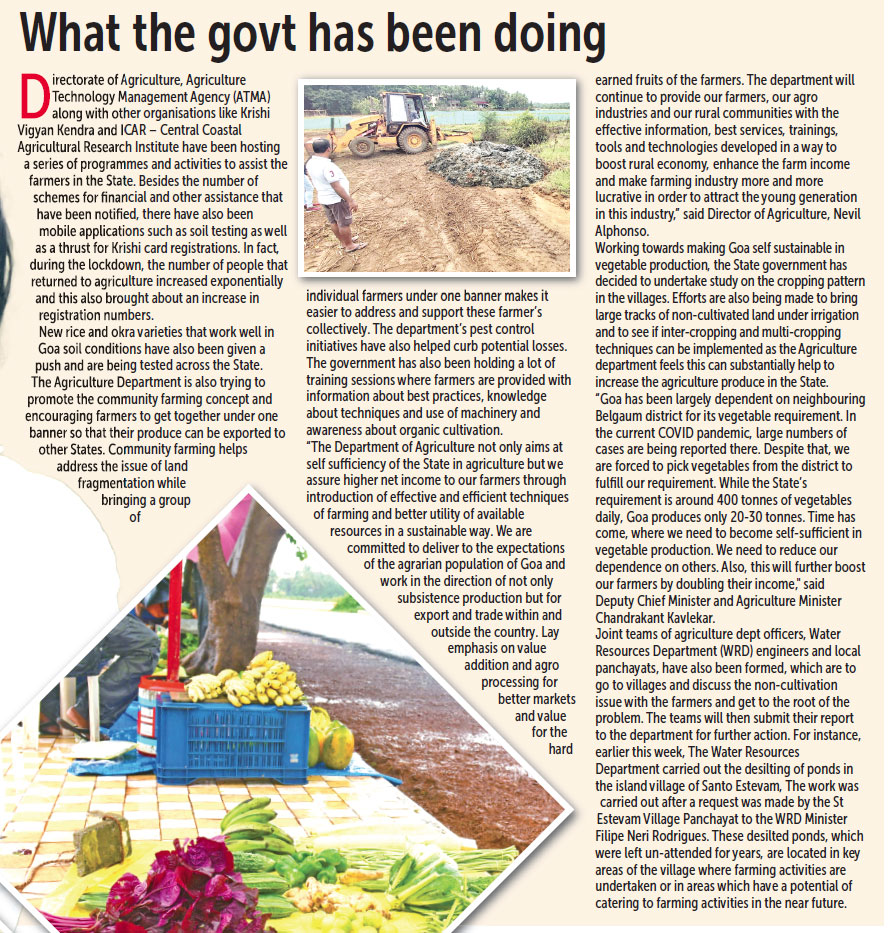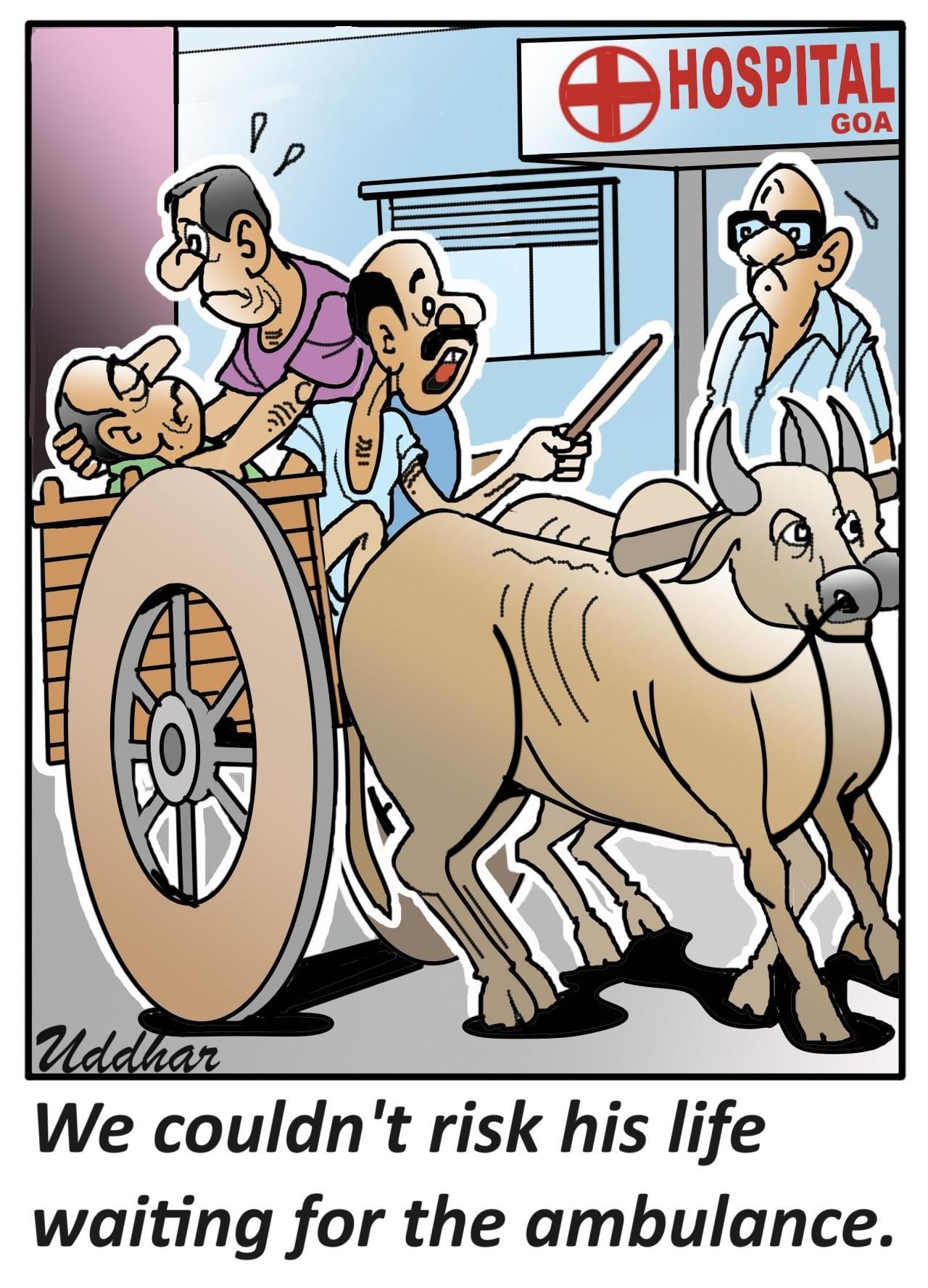
KARSTEN MIRANDA
A conversation at the local vegetable market between the customer and the vendor summed up what many on both sides of the equation are feeling.
The customer was lamenting that like every other commodity lately, the prices of the products on sale had increased drastically. What would be considered to be a non-expensive purchase is no longer cheap and what used to be expensive is now almost out of the reach of the common man.
For instance, the Mankurad mango is selling between two to three thousand a dozen while the Hapus variety is being sold at a rate of one thousand to two thousand per dozen. Raw cashew kernel is being sold at Rs 300 per 100 nuts. Even other non-vegetarian items like beef are being sold at Rs 350 while mutton is being sold for Rs 800 per kg.
The prices are soaring all over and the groans from customers continue.
What’s more troubling is that when it comes to retail goods inflation in Goa, prices of a regular food basket, such as grains, onion, potato as well other popular fruits diverge significantly from the national/State averages.
“I moved back to Goa recently and while the cost of living is definitely higher outside Goa, I found the cost of agri products to be more expensive as compared to the price of the same products sold in other States. There is close to a Rs 50 difference, for example, in the cost of apples that are sold in the State. With these perishable items, there is no real choice but to buy these if it is what you need,” said Reshma Shirodkar, an IT professional from Fatorda.
Incidentally, this prevailing situation coincides with the latest efforts of the State government, which is actively promoting its ‘Swayampurna Goem’ mission, whose aim is to transform Goa from being dependent on other States for supplies, to a State that is self-sufficient. This is on the lines of the Aatmanirbhar Bharat plan of Prime Minister Narendra Modi, which translates to a self-reliant India.
This has put the onus on the farmers of Goa to raise their production levels.
The farmers though, to begin with, are not too happy with the questions regarding their steep prices, justifying that it is just a reflection of the basic principles of economics, supply and demand. Then they say they are wary of the government’s plan materialising in the near future and expect things to remain as it is in the interim period.
“There is a saying; you have to learn to walk first before you can run. In Goa, we farmers face a myriad of problems and these have to be addressed first as otherwise we face the same cycle every year where this or that hurdle affects our ability to come out with a regular-sized produce, forget being able to substantially increase our production level,” says Sylvester Coelho from Quepem.
Experts in the field are also cautious about such an ambitious task given the existing scenario.
“It is important to remember that not all crops can be grown in Goa. Instead of thinking in generic terms like self sufficiency, we need to think of a larger dynamic of engaging in crop diversification while maintaining a strong ecological balance to promote soil and water health. Self sufficiency, as is, may not work and plunge the state into a serious agro-ecological crisis,” said Nikhil Goveas, Head of Special Projects, Koan Advisory.
Nikhil works with farmers to set up agri-value chains for horticulture commodities in the Konkan region.
Regarding the high prices seen in Goa, Nikhil pointed out that there are several factors of supply chain efficiency including sourcing of products, levels of intermediaries, cold storage and warehousing, processing capacity that can affect retail prices.
The common consensus amongst local stakeholders is that the issue of pricing and self-sufficiency go hand in hand and that the hike in prices are linked to the corresponding market conditions that are heavily influenced by goods coming from outside the State.
There is a complaint from local farmers that sometimes, their goods are often overlooked by those players who play a role in controlling the market and instead the non-Goan produce is more aggressively marketed and sold.
At the same time, questions have been raised as to why do products, which are found in Goa itself, are still on the higher side.
On this topic, veteran horticulturalist Miguel Braganza said, “In economics, there is a concept of ‘opportunity cost’ and also another of ‘price flexibility’ over demand at constant supply. In Goa, the supply of Mankurad mangoes in the market has not been increased by creating any plantation. There is no concerted effort even while implementing the Central Government scheme to plant a single variety. As more people afford and want, the demand increases at constant supply. It is the first law of Adam Smith: price increases. That is why PM Modi's dream of doubling farmer’s income cannot be realised by increasing production. Production is the supply side. We have to increase the demand side.”
He also asserted that as long as the cost of labour is high in Goa, lower price for local produce is impossible and he gave the example of how a mango plucker charges Rs 1,500 per day.
Sachin Tendulkar, a noted agriculturalist also concurred that their operational costs have also increased, which is a factor ignored during topics of increase in prices.
“For years the price of coconut has remained relatively the same. But during those years, the cost of maintaining the coconut plantation has increased manifold. That is not to mention the cost of family labour. The returns for coconut farmers who are in the elite financial bracket may get say Rs 15,000 per month and it is not a case of them getting such returns every month. You can imagine the plight of the poor and marginalised farmers who have far smaller areas for cultivation,” said Sachin.
In fact, officials at the Directorate of Agriculture estimate that the land holding of farmers of Goa is small and nearly 80 per cent of farmers own less than one hectare of land.
Sachin also felt there is a better sense of safety when it comes to local products, which can justify the pricing as local farmers consume the same produce they make and then sell the balance produce, which ensures that their products are safe and there are no dangerous artificial additions to them.
Nestor Rangel, who has been behind the successful community farming in St Estevam, Santa Cruz, Divar, Dongri, etc, and is a proponent of organic farming, also elucidated his opinion on this issue.
“Firstly and most importantly Goa is no longer an agrarian State in the sense that a farmer will not be able to survive if he/she loses a crop or does not get a proper price. If you take the case of vegetables, in other States nearly the entire cultivation from start to harvesting is a family affair. In Goa labour is hired for every activity and the volumes are less. Hence prices will be more,” he said.
“Also people use the word ‘ganvti’ or local, though there is a heavy use of chemical pesticides and fertilisers. There is no way that the farmer will be able to cover his expenses if he sells his/her produce at rates that are similar to those of other States. Cashew and mango is mostly unorganised and is not done at the levels as other States. Cashew though keeps a lot of locals busy from February to May. But usually the orchards are not cared for,” said Nestor, who is into cultivation of cashew, mango and exotic fruits as well.
Moving forward, stakeholders believe the government should use recommendations from committees like the recent State-appointed panel on khazan management that can bring about solutions to these problems.
Miguel felt that the government should have implemented the recommendations of Dr Raghunath Mashelkar-led Committee’s Goa Vision 2035, which has been gathering dust since August, 2012.
Speaking about finding solutions, farmers believe there is one problem that it is difficult to find solutions for.
What they fear the most and over the last few years, these fears have become a reality, is the unseasonal and extreme weather conditions where flash floods and cyclonic winds have played spoilsport. Crops that were ready for harvesting were lost or huge portions of areca nut trees fell due to water logging and strong winds. These are just some of their struggles.
While pointing out that the unseasonal rain has already affected the flowering season of Mangoes, which could lead to shortage in supply and further hike in prices, Sachin argued that an insurance concept needs to be introduced and questioned why this has not been done yet as it is the need of the hour. Nestor also touched upon hurdles farmers have faced in getting compensation after facing losses to the crops.
Against this backdrop, stakeholders feel strategic planning has to revolve around the recent study on Climate Change.
The State government had appointed NABARD consultancy services – NABCONS – to prepare the State Action Plan for Climate Change (SAPCC), project concept note and detail project report. The report said the mean annual rainfall in Goa is projected to slightly decline under high emission scenarios, which under low emission scenarios is projected to slightly increase.
“The flood vulnerability analysis from the State reveals that 14.73 per cent of the land is under 15 metre elevation, much of it in the coastal zones and are severely vulnerable to flooding both from extreme rainfall events and sea-level rise. In terms of vulnerability from floods and sea-level rise, the talukas Salcete, Tiswadi and Bardez are most vulnerable,” said SAPCC.
“Mean annual temperatures (model ensemble) in Goa may increase by around 2degrees C in 2030s compared to the 1901-1950 period, and further by around 4 degrees C by 2080s under high emission scenarios. Goa will start experiencing heat waves (>40 C) beyond the 2040s, as maximum temperature increases towards the century end under high emission scenarios. Minimum temperatures are expected to rise even more by up to 8 degree C by the century-end under the high emission scenarios,” it added.

On this note, Vince Costa, who came out with the award-winning documentary ‘Saxtticho Koddo: The Granary of Salcete’, for which he spent time with the farming community, said it is important to assess Goa’s long-term needs keeping in mind how climate change will affect us over the next twenty years.
“Firstly, when we speak of agricultural produce and self dependency, it’s important to define what is this produce we are talking about. Agriculture has become associated mostly with paddy cultivation. But there is more to it than paddy. Goa historically has never been self dependent even when almost all cultivable areas were cultivated and the population was much smaller. Paddy still came from outside of Goa. So, today when we are a much larger population and growing lesser, just a desire to become self dependent is not enough. The government wanting us to become self dependent is a great start, but how really is the question? Data is a good place to start. Without context, you can’t really make a wider plan. It’s important to use the current statistical data to understand where we stand as of now. Once we understand that, I think we need to look at a projection of where we will be in 20 years as a population and what food requirements will be there? Solving this problem that is faced not just by Goa, but is a global question, needs to be a conversation, not a monologue. The solution to this conundrum must be based in science and not emotion. How we feel doesn’t affect the weather, what we do environmentally does,” he added.
Even GOACAN (Goa Civic and Consumer Action Network) has approached the Directorate of Agriculture, calling for an action plan to combat soil erosion and protect soil biodiversity in Goa so that agriculture gets a boost and farmers get high returns. They had also listed how many farms had got damaged.
Tendulkar, who also was a former Director of Agriculture, felt the use of data was important and pointed out that corporations like Horticulture Corporation were formed to increase production which in turn would help address the costs and other issues too.
He said planning is critical and gave the example of how there was a recent trend when it comes to growing chillies but that there should have been a calculation on how much is required as there was surplus production, which also created wastage issues.
Others also felt that there should be better surveillance and use of storage facilities and yards to ensure that to reduce wastage and other problems.
“There are different types of fields in different areas of Goa. I think there are sufficiently qualified personnel in the Agriculture Department who should identify what can be grown and what shouldn’t. After identifying what type of soil, as well climatic conditions of that area, the crops should be suggested, a plan should be drawn up in consultation with that farmer and the identified crop should be grown. Just supplying seeds or seedlings, as is the case now, does not help. A certain amount of hand holding is required,” he added while stating that no other State gives as much of subsidies for agricultural activities as the Govt of Goa.

Seeds, planting materials, implements, machinery, fencing, irrigation, polyhouses power, training programmes; nearly every aspect is covered. What is missing is the implementation, handholding, accountability that the funds are being used properly with results. One prime example is the polyhouses which were given; 90 per cent are not being used. Some have even sold them,” he added.
Stakeholders like Nestor also pointed out that many vegetables and fruits are picked up by Goa and that the sale of produce through Horticulture Corporation stalls are at decent prices as compared to the retail market price.
In the end the stakeholders felt a holistic approach that addresses issues such as those of crops being destroyed by man-animal conflicts, diseases and other problems like management of sluice gates, etc, should be addressed first before any progress has to be made.
“Government of Goa has recently notified 0% interest through the Kissan Credit Card. It is definitely going to help farmers to avail agricultural credit at no interest if paid in time,” Sachin added.
Stakeholders added that a more consultative process from ground level to the higher up will help along with research-based inputs from experts that can even look into the issue of prices that customers are not happy with besides the problems faced by the farmers.
“We need to invite dialogue on this matter between governance, scientific institutions and society. And from those conversations distill out the priorities. Once these steps are done we can look at finding solutions to food security and not just for farming and agriculture. That will automatically include a wholesome solution where infrastructure, initiatives, supply and demand chain, value addition can align and be solved,” Vince added.
